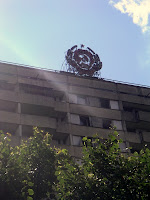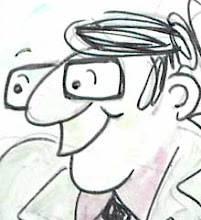 In a case in the museum room of the Kiev Philharmonia are some relics of Ukraine's 'God of the voice', the magnificent bass Boris Gmirya. It somehow reduces his scale to see his glasses, collar and (pre-made) bow-tie - a reminder that even Gods may have human - or even clay - feet. As I was just about to hear a performance of Shostakovich's Fourth Symphony - which I will presently eulogize - I was reminded of an occasion when Gmirya showed he was all too human. In 1962 he was Shostakovich's choice to sing the solo role in his controversial 13th Symphony, 'Babi Yar', with Mravinsky conducting. Under Party pressure, both withdrew. (Kondrashin, who did conduct, received a phone call during the dress rehearsal from the Minister of Culture, 'suggesting' that he might not be well enough to go on stage).
In a case in the museum room of the Kiev Philharmonia are some relics of Ukraine's 'God of the voice', the magnificent bass Boris Gmirya. It somehow reduces his scale to see his glasses, collar and (pre-made) bow-tie - a reminder that even Gods may have human - or even clay - feet. As I was just about to hear a performance of Shostakovich's Fourth Symphony - which I will presently eulogize - I was reminded of an occasion when Gmirya showed he was all too human. In 1962 he was Shostakovich's choice to sing the solo role in his controversial 13th Symphony, 'Babi Yar', with Mravinsky conducting. Under Party pressure, both withdrew. (Kondrashin, who did conduct, received a phone call during the dress rehearsal from the Minister of Culture, 'suggesting' that he might not be well enough to go on stage).Twenty-five years earlier, the Fourth Symphony had a similarly traumatic transit. It was scheduled for a premiere in Leningrad; but the composer, having been denounced earlier that year in Pravda for his opera Lady Macbeth of Mtsensk, found it expedient to withdraw it at the last minute, producing a year later the (superficially) more conformist Fifth Symphony. The Fourth was not heard until 1961 (Kondrashin conducting) and its reappearance at the time when 'Babi Yar' was gestating is surely not coincidental.
In tonight's spectacular performance by the Ukraine National Symphony Orchestra under Volodymyr Sirenko, it was clear why Shostakovich might have had his second thoughts in 1936. for this is a profoundly subversive work at the deepest levels. Clearly Mahlerian in its scale, its length, its use of sleazy waltzes and bird song, its shattering climaxes and its episodes of solo woodwind and brass instruments exposed against the orchestra like dissidents in conformist societies, it is also Mahler though a distorting mirror; or maybe Mahler modified by one of Einstein's tensors of relativity that can transform one universe - the Austro-Hungarian Empire - into another, the Soviet Union, both different and the same. These are the sort of ideas - even in an inexplicit art such as music - that no authoritarian state could tolerate.
As with Mahler, however, if this music is not driven, it becomes merely bloated. There was no risk of this with Sirenko and his band. Not only the orchestra, but also the audience, were totally gripped as Shostakovich's long paragraphs unfolded. The loose symphonic structure of the two lengthy outer movments renders them sequences of
 striking aural tableaux, whose contrasts suggest an alienation and individualism clearly at odds with the political strictures of 'popular culture'. The middle movement evaporates in an inane dance-rhythm; the last movement ends in dark, brooding chords. By the end of the work, we had all been expertly led on a most disturbing voyage. The audience rose as one to give conductor and orchestra - and the spirit of Shostakovich - a standing ovation. This was the fnest performance of this strange work I have ever heard, and indeed was the best Shostakovich performance I have heard in years.
striking aural tableaux, whose contrasts suggest an alienation and individualism clearly at odds with the political strictures of 'popular culture'. The middle movement evaporates in an inane dance-rhythm; the last movement ends in dark, brooding chords. By the end of the work, we had all been expertly led on a most disturbing voyage. The audience rose as one to give conductor and orchestra - and the spirit of Shostakovich - a standing ovation. This was the fnest performance of this strange work I have ever heard, and indeed was the best Shostakovich performance I have heard in years.






















